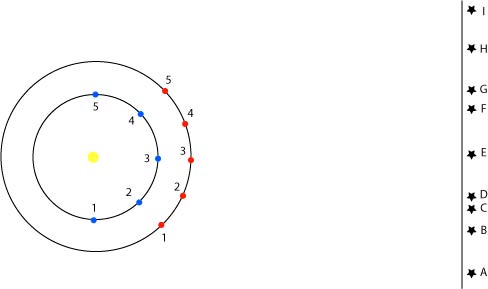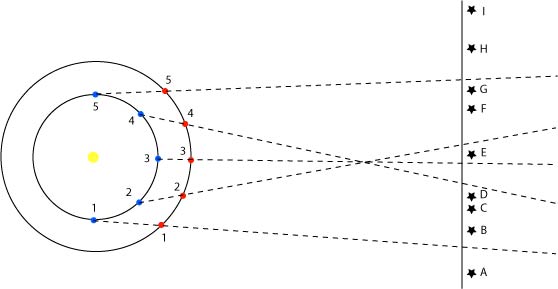 Retrograde Motion
Retrograde Motion
So. You’ve heard of retrograde motion, and you’ve seen it in a planetarium or a video, and heard from your favorite astrologer that it means that now is not the time to start a new relationship, especially since the Moon is in Venus’s house (huh?). But now you want to explain it scientifically to someone, and you’re kinda stumped as to how to begin. What is retrograde motion really? Something about planets going backwards? Remember this: Retrograde happens when an inner planet laps an outer planet.
Different Kinds of Retrograde:
Retrograde is a common word. “Retro” means “backwards,” and “gradus” means “step,” put together you get “going backwards.” Let me mention the three top kinds of retrograde in astronomy:
Retrograde Rotation: any planet that spins opposite from the other planets is said to have retrograde spin. Venus is one such planet. This is caused by the tidal lock between Venus, the Sun, and the Earth.
Retrograde Orbits: any planet or moon that orbits in the opposite direction from others is said to be in a retrograde orbit. This is uncommon among larger ojects: the largest retrograde moon Triton (around Neptune), which is one of the reasons that scientists think it is a captured moon.
Apparent Retrograde: when a planet appears to go backwards in the sky. This is the more complicated one, so now we’ll launch into more detail. Remember this: Retrograde happens when an inner planet laps an outer planet (because inner planets are moving faster than outer ones).
Apparent Retrograde Motion:
As you go through a day, the stars, the Moon, the Sun, and the planets all appear to rise in the East, and set in the West, because the Earth is spinning.
As you go through a month or a year, the Sun appears to move from WEST to EAST across the background stars. Go into a planetarium (or download Stellarium) and try it. This is normal. This is called prograde or direct motion. Now watch the planets, start with Saturn or Jupiter, they also mostly move from WEST to EAST across the background stars. This is both because the Earth is revolving around the Sun, and because the planets themselves are revolving around the Sun.
Now watch Mercury for about two months. Yikes! Did you see that? It just went backwards. (No? Then go download Stellarium like I told you, and look at it! Here’s a video if you’re lazy: Mars in Retrograde) It traveled from EAST to WEST across the background stars? This is because it’s on the inside of the solar racetrack, and it just passed us. We’re eating Mercury’s dust. Remember this: Retrograde happens when an inner planet laps an outer planet.
WHAT?
Okay, let’s add some pictures, some Java applets, and some videos.
First, go play with this: applet from UIUC You’ll need to have Java installed and functional, and to start it going click the middle blank button.
Now, I have a worksheet for you. Hah! Thought you’d never get homework from AstroInfo, didn’t you? Seriously folks, this will help you understand it if you don’t get it yet. And I’m not grading it.
Drawing Fun!

Earth and Mars from Above (NOT TO SCALE)
The inner (blue) dots are the Earth. The outer (red) dots are Mars. The lettered stars over on the right are background stars. As the Earth orbits the Sun, so does Mars. The numbers are to show time passing. When Earth is at position 1, Mars is at position 1. When Earth is at position 2, Mars is at position 2. Etc.
Draw a straight line connecting Earth 1 with Mars 1. Extend the line out to the background stars. These are the stars that Mars appears to be between, if you were looking up from Earth. If you look up from Earth at night, away from the Sun, you’ll see Mars, and some of the background stars.
Now do the same thing for Earth 2 and Mars 2. Do all 5 positions.
The Sky from Earth’s Point of View
If you were standing on Earth, looking up at those numbered stars, it would look something like this. Now draw in where Mars would be when Earth is at position 1 and Mars is at position 1. Repeat for positions 2-5. Be sure to number each Mars.
Connect the Mars dots from 1-5. You should get a loop. That’s Mars retrograding. Remember this: Retrograde happens when an inner planet laps an outer planet.
Here’s what I get:

Earth and Mars from Above

The Sky from Earth’s Point of View
Now go play with that Java applet again.
These drawings are not to scale, but they serve to get the point across. You’re welcome to try doing one for Mercury and Venus.
When you do, answer me this: which side of the Sun is Mercury on when it goes into retrograde? On the side closer to the Earth, or the side farther from the Earth?
Remember this: Retrograde happens when an inner planet laps an outer planet.
Want More?
Stellarium
YouTube Mars Retrograde Video
Retrograde applet.
Where’d I Get My Info?
The best dictionary ever, the Oxford English Dictionary. (if you have a library card with Seattle Public Libraries you get free access to their online dictionary).





